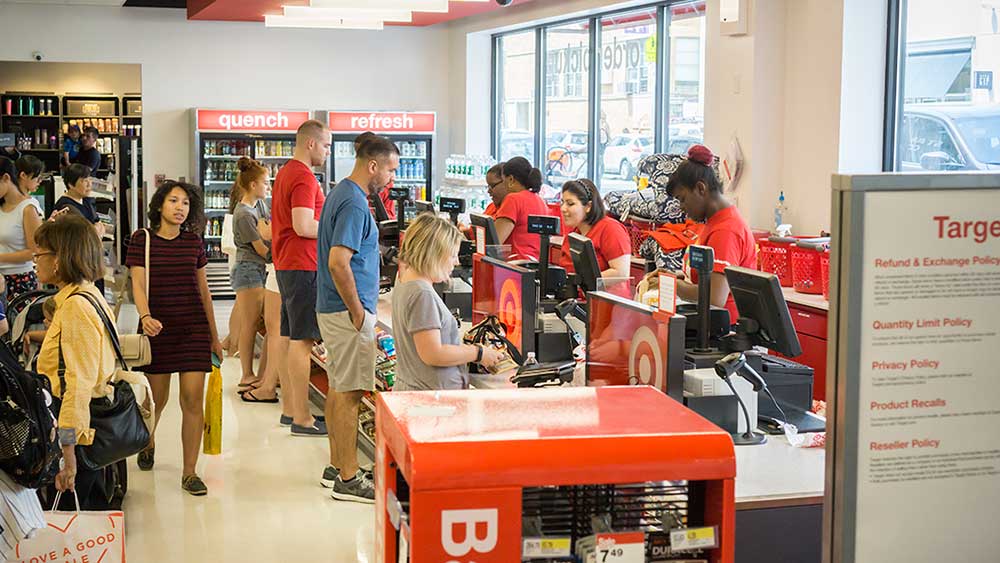Federal Reserve policymakers convinced that low unemployment will feed through to higher wage gains will take comfort from Monday's big announcement that Target (TGT) will hike its minimum wage from $10 an hour to $11 next month, reaching $15 by 2020.
Target seems to be proving the Fed hawks right: The retailer's move is, first and foremost, a bid to limit employee turnover and attract 100,000 seasonal workers in a tight labor market. It follows last month's Amazon.com (AMZN) jobs day, recruiting 50,000 people to work for $12 an hour or more, which attracted huge crowds of people.
By telegraphing wage hikes for the next few years, Target is making a long-term bet that by becoming an employer of choice, it will make both employees and customers happy and allow it to thrive — not just survive — amid a battle for domination between Wal-Mart (WMT) and Amazon.
Target's impact on the labor market is significant, with its 330,000 employees, though it doesn't approach that of Wal-Mart, whose base wage hike to $10 an hour last spring led Target, Costco (COST) and a host of other retailers to respond with wage hikes. "I think it will be a game where other retailers are going to have to match," Edward Jones analyst Brian Yarbrough told Minnesota Public Radio. "Now you're going to have wage pressure for the next several years."
Advertisement
IBD'S TAKE: Try out premium IBD features for free through Oct. 8. Popular features include exclusive stock lists, IBD Stock Checkup, which ranks the leaders in 197 industry groups based on earnings, sales, margins and stock performance; and The Big Picture daily update of the underlying market trend. On Aug. 22, IBD shifted its market trend gauge to "confirmed uptrend" from "uptrend under pressure," the equivalent of a flashing yellow light turning green.
The big question for the Fed is whether better wage gains will necessarily lead to higher inflation. The answer: Probably not any time soon. Just ask Target, which announced three weeks ago that it was cutting prices on thousands of items. That came shortly after Amazon celebrated the close of its Whole Foods acquisition by cutting the upscale natural foods grocer's prices as much as 43% on items like avocados and kale.
Higher wages may not feed through to higher prices in the near-term especially when a few huge companies have significant market power and incentives to put market share over profit. Amazon has been rewarded with a massive valuation because of sales growth and the growing reach of its Prime membership, even as profits have disappointed.
Internet-enabled price transparency also keeps a lid on prices, and that's not just true of retail. Marriott International (MAR) CEO Arne Sorenson explained last month that the hotel group doesn't have as much ability to raise prices as it had in past cycles. While home-sharing via Airbnb has some impact on leisure travelers and business travel is pretty good, not great, he sees the bigger issue as "radical transparency in pricing."

"It's not particularly focused on home sharing or the disrupters in the space," Sorenson said on an earnings call. "It's much more about just the ubiquity of information. And I think with each passing year, it becomes simpler and simpler to know the rates at every single hotel."
Yarbrough notes that Wal-Mart saw better employee retention and higher sales after its wage hikes, but the higher sales weren't enough to offset the extra costs. While Wal-Mart obviously has the financial strength to hike wages, the question is whether retail-sector laggards will be able to follow suit. If not, will the inability to hang onto quality workers hasten their demise?
At some point, the strong retailers that emerge from this hypercompetitive period may be able to raise prices, but who knows when?
Federal Reserve chief Janet Yellen, in a Tuesday afternoon speech, conceded that structural shifts may be affecting price rises, but still says that recent low inflation is "probably temporary." But she stressed that it would be imprudent to wait until inflation hits 2% before tightening.
Target Lifts Minimum Wage To $11 Per Hour, Aims For $15 By 2020
The Fed Doubles Down: Reverses QE, Keeps Hawkish Tilt
Here's What Is Eating At Inflation — And The Fed's Consensus
Stocks To Buy And Watch: Top IPOs, Big And Small Caps, Growth Stocks